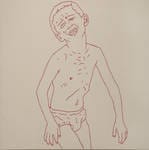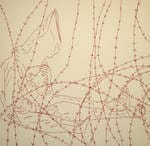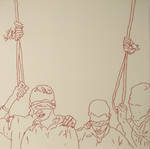6th May 2011 — 5th June 2011
I knew little of Franko B when I hit the Nunnery in Bow one sunny Sunday. It's a name both enigmatic and sinister. The letter B in place of a surname, more like some chemical compound than anything you might find on a birth certificate. It reminded me of something I couldn't quite place, and then I got it –Zyklon B, the stuff the Nazis used in the gas chambers. Then there's the title of the show itself– 'I STILL LOVE' – three words, a defiant assertion to sit alongside those of Gloria Gaynor or Scarlet O'Hara. But the title is an incomplete sentence, surely it should read –I still love despite….. but despite what?
I enter the first of three rooms, relieved that for the moment I am the only body in the place. The room is high, white and bright. Together on one wall are six large unpainted canvases. They hang on the wall somehow quietly, simply; their sandy warmth, their soft, clean mattness throwing a stillness and calm over everything, but then slowly, images emerge.
The pictures, clearly taken from photographs, are executed in white thread sewn upon the canvas. There is something craftsy about them, like something that should come free with a magazine, something with horses and a cottage. But the effect here is infinitely more delicate, little more than a suggestion of forms. In fact they would be soporific if it weren't for their subject matter: a man tied to a chair being tortured, a row of men, nooses round their necks, a semi-naked child running, screaming towards the viewer; but then in the midst of such horror – a bird; some mute witness, passing silent judgment on these atrocities, or waiting perhaps, with sharp beak and sharp eyes to feast on the human carnage.
Another enigma – one of the canvasses remains blank. This perhaps is the most sinister of all, placed as it is alongside such familiar images of man-made cruelty; notions of censorship come to mind, things too horrifying for the teatime news.
The next room presents us with nine more canvasses, but now the string has changed to scarlet thread. I remember being reprimanded once when painting an old bedroom – “You can't put red with white - it's blood and bandages!” And the effect now is strong indeed, the images jump out, unashamed; it seems the first room was just a warm-up.
The centre-piece has two young men kissing, their eyes lovingly closed. It feels natural, gentle, slow. In another, a man sits laughing with a dog, quite literally letting it all hang out. Opposite, a headless portrait of two unidentified men, their cocks lightly touching. These are intimate pictures, full of trust and familiarity and even a kind of child-like innocence. But then, without warning two images from the previous room reappear – the screaming boy and the hanged men. Picked out in red they are that much more insistent, they demand to be seen. In a way they accuse – have you forgotten us so quickly? The theme continues, further along the wall. It's an image depressingly familiar, that of an Iraqi prisoner, dragged on a lead in Abu Ghraib. It's horrifying, iconic, and amongst it all, two more birds. But now at last, the title begins to make sense. I STILL LOVE – a defiant assertion of innocence, beauty, something pure in the face of man's inhumanity to man: birdsong in the face of degradation, love and sex in the face of war.
I move into the last and largest room in the exhibition where more than twenty canvasses cover three walls. The room has an almost church-like serenity, a feeling of order and balance, at least when taken as a whole. But soon my eye is picking out new images of cruelty, another roll-call of suffering: a lynched man, a child soldier, barbed wire, a child lying dead, as well as a series of darkly enigmatic portraits of soldiers. Their faces are young, their expressions vacant, sometimes brutal; all the more sinister for their lack of context. No birds now but flowers – flowers and a reprise of the kissing boys. It is the main, facing wall though, that roars. Three canvasses in a row. A young man, nude with an eye-watering slash of stitches from left to right across his middle - another victim of the cold-eyed brutality leering down all around us? I look again; he is scarred, maimed, hurt – but defiant. In one canvass his fists are raised in boxing pose; his eyes meet ours. So he is the 'I' of the show's title. He is the one who STILL LOVES, still loves in spite of the cruelty, in spite of the horror.
Back outside, the alleyway is still littered with fag ends and broken glass and there is still a pungent smell of piss but the sun is shining and the birds really are singing, it feels more like July than May.
Toby Winter

Franko B – I Still Love' 2009/2011'

Franko B – I Still Love' 2009/2011'

Franko B – I Still Love' 2009/2011'

Franko B – I Still Love' 2009/2011'